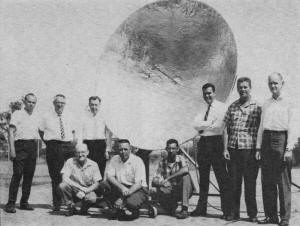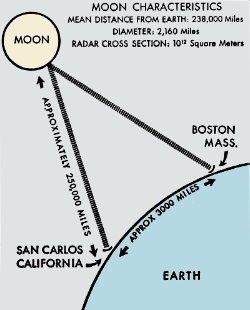Ham Radio Earth-Moon-Earth Contact
|
|
We recently passed the 62nd anniversary of the first successful earth-moon-earth (EME) communication path by amateur radio operators. What is today a routine operation by Hams was a big deal back in the day. The moon was still a mystery to most of the world since at the time not even an unmanned probe had been sent for exploration. As reported in this 1960 issue of Electronics World magazine, 1,296 MHz was the frequency of choice using a 1 kW klystron on the transmit end and a highly sensitive parametric amplifier on the receive end, with high gain parabolic antennas on both ends. The Federal Communications Commission (FCC) has allocated the 144.00-144.20 MHz (2 m), 222.0-222.025 MHz (1.25 m), 432.00-432.07 MHz and (70 cm), 902.8-903.0 MHz (33 cm), 1295.8-1296.05 MHz (23 cm), and 2303.9-2304.2 MHz bands for various modes of EME operation per Part 97 rules. Ham Radio Earth-Moon-Earth Contact Some members of the Eimac Radio Club in San Carlos, California, who participated in the moon-bounce circuit are shown here with their make-shift parabolic dish. Details on the first amateur radio moon-bounce two-way microwave contact between California and Massachusetts. The first amateur radio moon-bounce two-way microwave communication took place on Sunday, July 17 between two distant points. This contact marks an important milestone in the development of amateur radio. The historic contact was between the members of the Eimac Radio Club in San Carlos, California and Mr. Sam Harris, Rhododendron Swamp VHF Society in Medfield, Mass. After months of personal effort by the radio amateurs concerned with this project, signals were transmitted in both directions on 1296 mc. The equipment was then refined and the first successful two-way communication was made. The first transmission was from West (W6HB) to East (W1BU). The pattern was then reversed and the first amateur coast-to-coast communication via the moon completed. At each end of the circuit, a 1000-watt klystron was used in the transmitter and a very sensitive parametric amplifier in the receiver. This successful reception and transmission using the moon as a signal reflector will stimulate efforts to improve amateur-built equipment for further moon-bounce communications. The only other moon-bounce communications equipment in existence is military or experimental in nature; the principal installation is the Naval link between Washington and Hawaii. Members of the Eimac Radio Club who participated in the moon-bounce circuit are: Bill Orr, W6SAI; Hank Brown, W6HB; Bill Eitel, W6UF; Ray Rinaudo, W6KEV; Bob Morwood, K6GJF; Bob Sutherland, W6UOV; Hugh MacDonald, W6CDT; George Badger, W6RXW; Allan Beer, K6GSO; Al Clark, W6MUC; Mike Krivohlavek, K6AXN, and Charlie Anderson, W6IVZ.
Posted December 2, 2022 |
|


